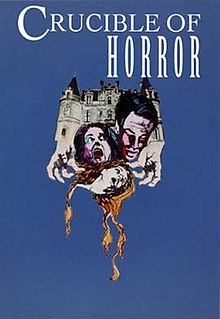
Rupert Alexander Lloyd Grint is an English actor. He rose to fame for his role as Ron Weasley, one of the three main characters in the Harry Potter film series. Grint was cast as Ron at age eleven, having previously acted only in school plays and at his local theatre group. From 2001 to 2011, he starred in all eight Harry Potter films.
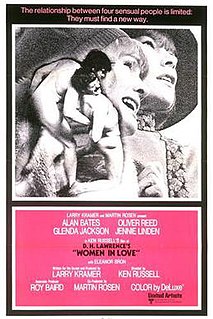
Women in Love is a 1969 British romantic drama film directed by Ken Russell and starring Alan Bates, Oliver Reed, Glenda Jackson, and Jennie Linden. The film was adapted by Larry Kramer from D. H. Lawrence's 1920 novel Women in Love. It is the first film to be released by Brandywine Productions.

Play Misty for Me is a 1971 American psychological thriller film directed by and starring Clint Eastwood, his directorial debut. Jessica Walter and Donna Mills co-star. The screenplay, written by regular Eastwood collaborators Jo Heims and Dean Riesner, follows radio disc jockey (Eastwood) being stalked by an obsessed female fan (Walter).

Francis Michael Gough was a British character actor who made over 150 film and television appearances. He is known for his roles in the Hammer Horror Films from 1958, with his first role as Sir Arthur Holmwood in Dracula, and for his recurring role as Alfred Pennyworth in all four films of the Tim Burton/Joel Schumacher Batman films. He would appear in three more Burton films: in Sleepy Hollow, voicing Elder Gutknecht in Corpse Bride and the Dodo in Alice in Wonderland.

The Oxford Book of Twentieth Century English Verse is a poetry anthology edited by Philip Larkin. It was published in 1973 by Oxford University Press with ISBN 0-19-812137-7. Larkin writes in the short preface that the selection is wide rather than deep; and also notes that for the post-1914 period it is more a collection of poems, than of poets. The remit was limited by him to poets with a period of residence in the British Isles. Larkin's generous selection of Thomas Hardy's poems has been noted for its influence on Hardy's later reputation. On the other hand, he was criticized, notably by Donald Davie, for his inclusion of "pop" poets such as Brian Patten. The volume contains works by 207 poets.
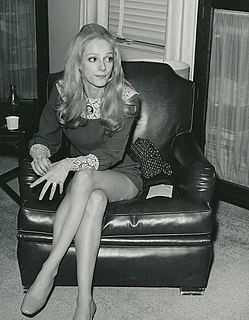
Sandra Louise Anderson, professionally known as Sondra Locke, was an American actress and director. She made her film debut in 1968 in The Heart Is a Lonely Hunter, for which she was nominated for an Academy Award for Best Supporting Actress. She went on to star in such hit films as Willard, The Outlaw Josey Wales, The Gauntlet, Every Which Way but Loose, Bronco Billy, Any Which Way You Can and Sudden Impact. She worked often with Clint Eastwood, who was her companion for 14 years. She also directed four films, notably Impulse. Locke's autobiography, The Good, the Bad, and the Very Ugly: A Hollywood Journey, was published in 1997.

Antony Balch was an English film director and distributor, best known for his screen collaborations with Beat Generation author William S. Burroughs in the 1960s and for the 1970s horror film, Horror Hospital.
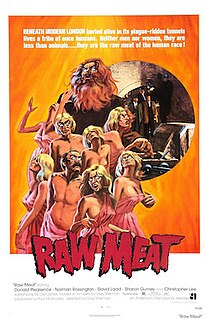
Death Line is a 1972 horror film written and directed by Gary Sherman and starring Donald Pleasence, Norman Rossington, David Ladd, Sharon Gurney, Hugh Armstrong, and Christopher Lee. Its plot follows two university students who find themselves at the centre of an investigation involving a man who goes missing on the London Underground.
Olaf Krohn Pooley was an English actor, screenwriter and painter. As an actor, he appeared as Professor Stahlman in the seven-part Doctor Who serial Inferno (1970).
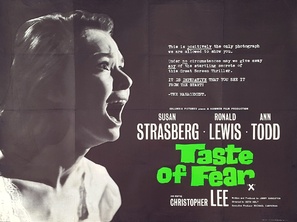
Taste of Fear is a 1961 British thriller film directed by Seth Holt. The film stars Susan Strasberg, Ronald Lewis, Ann Todd, and Christopher Lee in a supporting role. It was released in the United States as Scream of Fear.
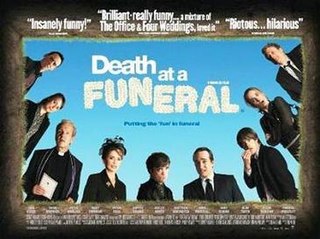
Death at a Funeral is a 2007 British black comedy film directed by Frank Oz. The screenplay by Dean Craig focuses on a family attempting to resolve a variety of problems, whilst they attend the funeral of the patriarch.
Fenella Woolgar is an English film, theatre, television and radio actress. She is known for her roles in the films Bright Young Things (2003) and Judy (2019).

Changeling is a 2008 American mystery crime drama film directed, produced, and scored by Clint Eastwood and written by J. Michael Straczynski that explores child endangerment, female disempowerment, political corruption, mistreatment of mental health patients, and the repercussions of violence. The script was based on real-life events, specifically the 1928 Wineville Chicken Coop murders in Mira Loma, California. The film stars Angelina Jolie as a woman united with a boy who she realizes is not her missing son. When she tries to demonstrate this to the police and city authorities, she is vilified as delusional, labeled as an unfit mother, and confined to a psychiatric ward.
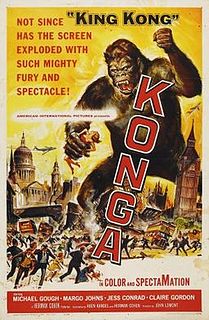
Konga is a 1961 technicolour British-American horror science fiction film directed by John Lemont and starring Michael Gough, Margo Johns and Austin Trevor. It was shot at Merton Park Studios and in Croydon for Anglo Amalgamated, then distributed in the United States by American International Pictures (AIP) as a double feature with Master of the World. Anglo Amalgamated and AIP each provided half the funding for the US$500,000 film, with each studio receiving distribution rights in their respective hemispheres.

The Flesh and the Fiends is a 1960 British horror film directed by John Gilling. It stars Peter Cushing as 19th-century medical doctor Robert Knox, who purchases human corpses for research from a murderous pair named Burke and Hare. The film is based on the true case of Burke and Hare, who murdered at least 16 people in 1828 Edinburgh, Scotland and sold their bodies for anatomical research.
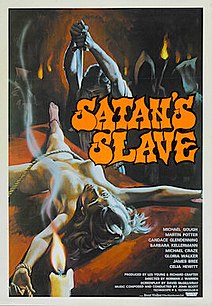
Satan's Slave is a 1976 British independent supernatural horror film written by David McGillivray and directed by Norman J. Warren. It stars Candace Glendenning as a young woman who, after surviving a car accident in which her parents are seemingly killed, is taken in by her uncle and cousin, unaware that they are both necromancers who intend to sacrifice her to resurrect the spirit of a supernaturally-gifted ancestor.

Crucible of Terror is a 1971 British horror film and directed by Ted Hooker and starring Mike Raven, Mary Maude and James Bolam. Its plot centres on a reclusive artist in Cornwall. Besides painting young women, he has encased the living body of one in plaster and poured into it, through an eyehole, molten bronze, which killed her, made a cast of her body and turned it into a beautiful sculpture. After the bronze sells at a good price, he finds a 'suitable' second woman and attempts to do the same. But before he can, he meets a grisly demise at the hands of the first woman, a member of a 'weird sect', whose spirit has possessed the body of the second woman.

The Autopsy of Jane Doe is a 2016 supernatural horror film directed by André Øvredal. It stars Emile Hirsch and Brian Cox as father-and-son coroners who experience supernatural phenomena while examining the body of an unidentified woman. It is Øvredal's first English-language film.

Separation is a 2021 American horror film directed by William Brent Bell, from a screenplay by Nick Amadeus and Josh Braun. It stars Rupert Friend, Mamie Gummer, Madeline Brewer, Violet McGraw, Simon Quarterman, and Brian Cox. It was released on April 30, 2021, by Open Road Films and Briarcliff Entertainment. The film received negative reviews from critics.
